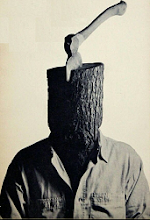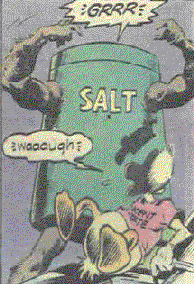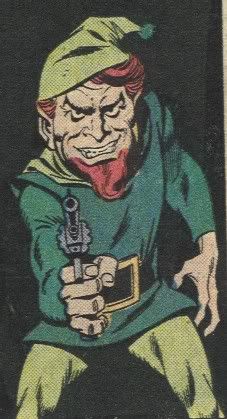The Mister Teeny Test
Avant-garde art is tough to judge. Nagging in the back of folks’ heads is the thought, “maybe it’s brilliant and I just don’t get it...hmmm...what am I missing?” Modern poetry is particularly tough in this regard.
I’ve developed a quick and dirty test to determine if a work is a complex web of fascinating imagery dedicated towards a significant point, or if it’s a bunch of crazy crap thrown together in an effort to appear “deep.”
I call it the Mister Teeny Test.
Mister Teeny is a cartoon chimp found on The Simpsons. He wears a fez and a bow tie, smokes, and sometimes wears roller skates. I dig him. As the Fourth Maxim of Comedy states, “all monkeys (including apes, etc.) are hilarious, especially when wearing human clothing.”
The test is this: could the comic/movie/whatever withstand the insertion of Mister Teeny in a random location without hurting the work? Take Blue Velvet, a David Lynch movie beloved by many. Would it be possible to splice in a single shot of a chimpanzee wearing a fez and smoking a Marlboro and not have it destroy the flavor of the movie? I think the answer is yes.
On the other hand, Lynch’s movie The Straight Story, given a smoking, roller-skating chimp, would be destroyed. All people would talk about afterwards would be “what’s with the chimp?”
The test is a personal one, but I stand by its usefulness.*
Recently I bought a miniseries published by Dark Horse a few years ago, called The Nevermen. It’s about a shadowy group of fellows in dark blue trenchcoats, hats and goggles that fight against strange menaces in a thirties/forties style city. The art looked snazzy and the idea held some promise. Plus, hey, I was able to get it cheap.
The Nevermen fails the Mister Teeny Test. Its aggressive weirdness and intriguing visual design, in the end, add up to nothing in particular. A roller-skating chimp wouldn’t have disrupted the proceedings in the least.
The story contained a crime boss who was a severed head, another who had a very realistic octopus for a head, killer robots, a mysterious scientific genius called “The Professor” (who reminded me of Oscar Wilde), the titular Nevermen, a mad scientist out to destroy the city with a poorly-explained thingy that would shatter time or something, and a pointless nod towards Blade Runner that falls under the category of “oh, come on.”
Altogether, it added up to diddly.
How annoying.
Mr. Teeny would have fit right in.
Now take another bizarro comic: Grant Morrison’s Arkham Asylum. I think it’s overrated crap, weirdness for the sake of weirdness. But it passes the Mister Teeny Test with flying colors. You couldn’t wedge a roller-skating chimp anywhere in there.
It still sucked, but its weirdness was at least directed towards an end, rather than for the joy of throwing strange crap on the page.**
There are few problems in this world that can’t be solved by the application of a chimp.
--------------
*The test (hereafter called the MTT) has certain obvious flaws. For example, if the story already contains a large number of monkeys, one more probably won’t mean much. (This does weaken its validity in testing Nevermen, which did have a lot of monkeys.)
Also, the test is not entirely a test for quality. It’s possible to create a comic or a movie that would fail the MTT but still be tremendously entertaining. (Certainly, passing the MTT guarantees nothing at all about quality.) However, the MTT is a good test of story integrity, an element of fiction I personally find quite valuable.
Also, the MTT isn’t a single binary test; it has three levels.
MTT Level One (MTT-1): The chimp is integrated into the scene, matching the appearence of the story around him. For example, picture an episode of Gunsmoke where Mr. Teeny would be a live chimp on skates, rolling past as Chester and Matt go on about Miss Kitty’s new hat. In a comic, the chimp would match the art style of the rest of the book.
This is the basic MTT, the divider between “focused story” and “bunch of crap thrown at a wall.”
MTT Level Two (MTT-2): The chimp still matches the art style and/or medium of the story, but he receives his own seperate shot or panel. He doesn’t just drift by, he seizes the whole story for a few seconds.
MTT Level Three (MTT-3): The story is interrupted by a cartoon panel/short clip of the actual cartoon Mr. Teeny.
A story is rated on the MTT scale by what level of Teeny it can take before he seems out of place. For example, Gunsmoke passes even the MTT-1. Much of Grant Morrison’s work fails the initial test, some fails level two, but very little fails the dreaded MTT-3. That takes an almost unbelievable randomness. The Nevermen is an MTT-2 story.
The inspiration for the test, Matthew Barney’s excruciatingly boring “film,” the Cremaster Cycle, is a full-blown MTT-3.
**Arkham Asylum lost me when Morrison broke out the single lamest idea in the hipster arsenal. It never fails to elicit a groan.
One of the doctors proclaimed that the Joker’s fragmented psyche, forced to recreate itself daily, could be viewed as “a kind of super-sanity.”
Oh, give it a goddamn rest.
“You know, maybe the crazy people are really the sane ones, man, ‘cause ya know they aren’t bound by the psycho laws of behavior that we are, man. They aren’t slaves, y’know, to the machine, man. They really see, they get it, and the squares don’t, man.” The subtext of the idea being, those who read this book “get it,” and they understand the world better than the straights, man.
Only when one is under the age of fifteen and under the influence of a forty-dog of St. Ides Malt Liquor does this idea sound profound. The rest of the time, it looks like flatulent self-congratulatory nonsense. “I’m, like, crazy, man...I see things and understand like nobody else. Nobody understands me, ‘cause I’m super-sane! My stupid mom doesn’t understand! It’s all a bunch of lies and hypocrisy anyway!”
It’s so old and feeble an “insight” it should be smothered with its own pillow.
To quote a wise man, "oy, gevalt."
I’ve developed a quick and dirty test to determine if a work is a complex web of fascinating imagery dedicated towards a significant point, or if it’s a bunch of crazy crap thrown together in an effort to appear “deep.”
I call it the Mister Teeny Test.
Mister Teeny is a cartoon chimp found on The Simpsons. He wears a fez and a bow tie, smokes, and sometimes wears roller skates. I dig him. As the Fourth Maxim of Comedy states, “all monkeys (including apes, etc.) are hilarious, especially when wearing human clothing.”
The test is this: could the comic/movie/whatever withstand the insertion of Mister Teeny in a random location without hurting the work? Take Blue Velvet, a David Lynch movie beloved by many. Would it be possible to splice in a single shot of a chimpanzee wearing a fez and smoking a Marlboro and not have it destroy the flavor of the movie? I think the answer is yes.
On the other hand, Lynch’s movie The Straight Story, given a smoking, roller-skating chimp, would be destroyed. All people would talk about afterwards would be “what’s with the chimp?”
The test is a personal one, but I stand by its usefulness.*
Recently I bought a miniseries published by Dark Horse a few years ago, called The Nevermen. It’s about a shadowy group of fellows in dark blue trenchcoats, hats and goggles that fight against strange menaces in a thirties/forties style city. The art looked snazzy and the idea held some promise. Plus, hey, I was able to get it cheap.
The Nevermen fails the Mister Teeny Test. Its aggressive weirdness and intriguing visual design, in the end, add up to nothing in particular. A roller-skating chimp wouldn’t have disrupted the proceedings in the least.
The story contained a crime boss who was a severed head, another who had a very realistic octopus for a head, killer robots, a mysterious scientific genius called “The Professor” (who reminded me of Oscar Wilde), the titular Nevermen, a mad scientist out to destroy the city with a poorly-explained thingy that would shatter time or something, and a pointless nod towards Blade Runner that falls under the category of “oh, come on.”
Altogether, it added up to diddly.
How annoying.
Mr. Teeny would have fit right in.
Now take another bizarro comic: Grant Morrison’s Arkham Asylum. I think it’s overrated crap, weirdness for the sake of weirdness. But it passes the Mister Teeny Test with flying colors. You couldn’t wedge a roller-skating chimp anywhere in there.
It still sucked, but its weirdness was at least directed towards an end, rather than for the joy of throwing strange crap on the page.**
There are few problems in this world that can’t be solved by the application of a chimp.
--------------
*The test (hereafter called the MTT) has certain obvious flaws. For example, if the story already contains a large number of monkeys, one more probably won’t mean much. (This does weaken its validity in testing Nevermen, which did have a lot of monkeys.)
Also, the test is not entirely a test for quality. It’s possible to create a comic or a movie that would fail the MTT but still be tremendously entertaining. (Certainly, passing the MTT guarantees nothing at all about quality.) However, the MTT is a good test of story integrity, an element of fiction I personally find quite valuable.
Also, the MTT isn’t a single binary test; it has three levels.
MTT Level One (MTT-1): The chimp is integrated into the scene, matching the appearence of the story around him. For example, picture an episode of Gunsmoke where Mr. Teeny would be a live chimp on skates, rolling past as Chester and Matt go on about Miss Kitty’s new hat. In a comic, the chimp would match the art style of the rest of the book.
This is the basic MTT, the divider between “focused story” and “bunch of crap thrown at a wall.”
MTT Level Two (MTT-2): The chimp still matches the art style and/or medium of the story, but he receives his own seperate shot or panel. He doesn’t just drift by, he seizes the whole story for a few seconds.
MTT Level Three (MTT-3): The story is interrupted by a cartoon panel/short clip of the actual cartoon Mr. Teeny.
A story is rated on the MTT scale by what level of Teeny it can take before he seems out of place. For example, Gunsmoke passes even the MTT-1. Much of Grant Morrison’s work fails the initial test, some fails level two, but very little fails the dreaded MTT-3. That takes an almost unbelievable randomness. The Nevermen is an MTT-2 story.
The inspiration for the test, Matthew Barney’s excruciatingly boring “film,” the Cremaster Cycle, is a full-blown MTT-3.
**Arkham Asylum lost me when Morrison broke out the single lamest idea in the hipster arsenal. It never fails to elicit a groan.
One of the doctors proclaimed that the Joker’s fragmented psyche, forced to recreate itself daily, could be viewed as “a kind of super-sanity.”
Oh, give it a goddamn rest.
“You know, maybe the crazy people are really the sane ones, man, ‘cause ya know they aren’t bound by the psycho laws of behavior that we are, man. They aren’t slaves, y’know, to the machine, man. They really see, they get it, and the squares don’t, man.” The subtext of the idea being, those who read this book “get it,” and they understand the world better than the straights, man.
Only when one is under the age of fifteen and under the influence of a forty-dog of St. Ides Malt Liquor does this idea sound profound. The rest of the time, it looks like flatulent self-congratulatory nonsense. “I’m, like, crazy, man...I see things and understand like nobody else. Nobody understands me, ‘cause I’m super-sane! My stupid mom doesn’t understand! It’s all a bunch of lies and hypocrisy anyway!”
It’s so old and feeble an “insight” it should be smothered with its own pillow.
To quote a wise man, "oy, gevalt."





5 Comments:
I thought the point of that scene in "Arkham Asylum" was that the psychiatrist who floated that theory was a moron. This is the same doctor who messed up Two-Face so badly that he couldn't even go to the bathroom without doing a tarot reading first. I took it as a critique of that kind of smug, power-tripping, "I know what's good for you better than you do" school of medicine. But YMMV.
--
J. Kevin Carrier
By Anonymous, at 11:55 AM
Anonymous, at 11:55 AM
But...but...doesn't the fact that Amaro and Davis could come up with such an imaginative world (and I think Blade Runner comparisons are stretching it a bit), populated with such oddball characters, and give them such florid dialogue, all in the service of a great pulp magazine pastiche, mean anything at all?
I respect and admire sheer imagination and the facile and clever usage of same...am I barking up the wrong metaphorical tree?
Right. Mister Teeny does not lie.
I liked The Nevermen a lot, apparently I'm easily entertained.
By Johnny Bacardi, at 1:09 PM
Johnny Bacardi, at 1:09 PM
This comment has been removed by a blog administrator.
By Harvey Jerkwater, at 4:23 PM
Harvey Jerkwater, at 4:23 PM
Hmmm...good comments both.
As far as "Arkham Asylum," I don't recall the doctor being pointed out as especially dense, but then again it's been ten years since I read it. Though her dopey comment stuck in my mind, it wasn't the core of my complaint with the book. It just seemed like a hollow exercise in style to me. Though man, that art. Damn.
The Mister Teeny Test explains why I feel "The Nevermen" was underwhelming. The art was cool. The world the series created was interesting. I dug a lot of the elements thrown together. But it didn't add up to much, since there wasn't a whole lot of underlying spine to the comic. It lacked coherence and drive. What could have been a damn fine book wilted to a nifty curiosity. Disappointing.
The "Blade Runner" comparison was the link I saw between the titular Nevermen and the replicants. At the end, when the defective Neverman discovers the truth, he worries about the validity of his memories and desires, then caps himself. The scene could have worked, and even been excellent, had it come from anywhere or gone anywhere. As it was, it fell on the reader like a large halibut and just sorta lay there.
"The Nevermen" frustrated the crap out of me. The elements of a great comic were there, but the writer opted for "cool idea overload" over "good story idea." Makes me nuts.
Yes, I'm really, really opinionated.
By Harvey Jerkwater, at 11:44 PM
Harvey Jerkwater, at 11:44 PM
I wish someone would do a list of "hip" comic cliches. How like for a while there were lots of characters with hypodermic syringes for teeth and fingers (I think "Stray toasters" started this, but saw it in "Tank Girl," too. )
By Jack Ruttan, at 12:59 PM
Jack Ruttan, at 12:59 PM
Post a Comment
<< Home